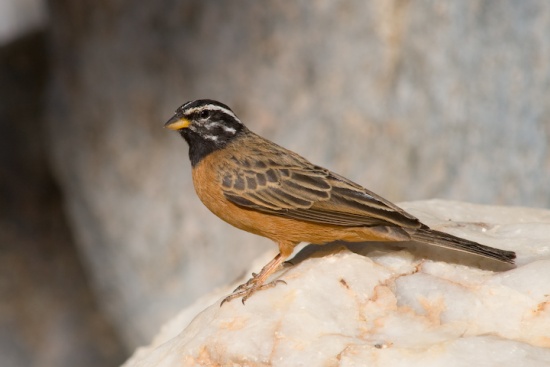(split of Gosling's Bunting) |
(Imp sizes. Picture of a 1st year bird. Some extra info. References updated) |
||
| Line 2: | Line 2: | ||
;[[:Category:Emberiza|Emberiza]] tahapisi | ;[[:Category:Emberiza|Emberiza]] tahapisi | ||
==Identification== | ==Identification== | ||
| − | + | 13–15 cm (5-6 in), mass 15 g<br /> | |
'''Adult male''': Head boldly striped black and white; mantle to upper tail coverts cinnamon with dark brown markings.Tail and flight feathers dark brown, edged cinnamon. Underparts cinnamon.<br /> | '''Adult male''': Head boldly striped black and white; mantle to upper tail coverts cinnamon with dark brown markings.Tail and flight feathers dark brown, edged cinnamon. Underparts cinnamon.<br /> | ||
'''Adult female''': Similar to the male, but paler; above less reddish. | '''Adult female''': Similar to the male, but paler; above less reddish. | ||
==Distribution== | ==Distribution== | ||
| + | [[Image:Bunt8a.jpg|thumb|350px|right|First winter<br />Photo by {{user|ammadoux|ammadoux}}<br />Sallalh, [[Oman]], August 2016]] | ||
[[Africa]] south of the Sahara and the [[Middle East]]<br /> | [[Africa]] south of the Sahara and the [[Middle East]]<br /> | ||
'''Eastern Africa''': [[Sudan]], [[Eritrea]], [[Ethiopia]], [[Djibouti]], [[Somalia]], [[Kenya]], [[Uganda]], [[Rwanda]], [[Burundi]], [[Tanzania]], [[Zambia]], [[Mozambique]] and [[Malawi]]<br /> | '''Eastern Africa''': [[Sudan]], [[Eritrea]], [[Ethiopia]], [[Djibouti]], [[Somalia]], [[Kenya]], [[Uganda]], [[Rwanda]], [[Burundi]], [[Tanzania]], [[Zambia]], [[Mozambique]] and [[Malawi]]<br /> | ||
| Line 25: | Line 26: | ||
Subspecies ''nivenorum'' is not generally recognised<sup>[[#References|[1]]]</sup>. | Subspecies ''nivenorum'' is not generally recognised<sup>[[#References|[1]]]</sup>. | ||
==Habitat== | ==Habitat== | ||
| − | Rocky and eroded areas and croplands, favoring patches of bare soil. | + | Rocky hillsides and eroded areas and croplands, favoring patches of bare soil. |
==Behaviour== | ==Behaviour== | ||
Some birds migrate but patterns of movement are not clear, others are resident. Solitary, in pairs, or in small groups. | Some birds migrate but patterns of movement are not clear, others are resident. Solitary, in pairs, or in small groups. | ||
====Diet==== | ====Diet==== | ||
| − | Forages on the ground for seeds and | + | Forages on the ground for seeds, fresh green leaves a wide variety of insects and nectar. |
====Vocalisation==== | ====Vocalisation==== | ||
A pleasant twitter. | A pleasant twitter. | ||
==References== | ==References== | ||
| − | #{{Ref- | + | #{{Ref-Clements6thAug16}}#Avibase |
| − | # | + | #{{Ref-Hockeyetal05}}#Fry H, Keith S,Woodcook M & Willis I. 2004. ''Birds of Africa Vol VII: Sparrows to Buntings''. Princeton University Press. ISBN 0713665319 |
| − | #Fry H, Keith S,Woodcook M & Willis I. 2004. ''Birds of Africa Vol VII: Sparrows to Buntings''. Princeton University Press. ISBN 0713665319 | + | #Handbook of the Birds of the World Alive (retrieved August 2016) |
{{ref}} | {{ref}} | ||
==External Links== | ==External Links== | ||
{{GSearch|Emberiza+tahapisi}} | {{GSearch|Emberiza+tahapisi}} | ||
[[Category:Birds]][[Category:Emberiza]] | [[Category:Birds]][[Category:Emberiza]] | ||
Revision as of 22:10, 23 August 2016
- Emberiza tahapisi
Identification
13–15 cm (5-6 in), mass 15 g
Adult male: Head boldly striped black and white; mantle to upper tail coverts cinnamon with dark brown markings.Tail and flight feathers dark brown, edged cinnamon. Underparts cinnamon.
Adult female: Similar to the male, but paler; above less reddish.
Distribution
Africa south of the Sahara and the Middle East
Eastern Africa: Sudan, Eritrea, Ethiopia, Djibouti, Somalia, Kenya, Uganda, Rwanda, Burundi, Tanzania, Zambia, Mozambique and Malawi
Southern Africa: Namibia, Botswana, Zimbabwe, South Africa, KwaZulu-Natal, Lesotho and Swaziland
Middle East: Arabian Peninsula: Saudi Arabia, Yemen, Socotra, Oman
Taxonomy
Gosling's Bunting was formerly included in this species.
Subspecies
There are generally 4 subspecies recognised[1]:
- E. t.tahapisi:
- E. t.septemstriata:
- E. t.arabica:
- Southern Arabia (Asir to Hadhramaut)
- E. t.insularis:
Subspecies nivenorum is not generally recognised[1].
Habitat
Rocky hillsides and eroded areas and croplands, favoring patches of bare soil.
Behaviour
Some birds migrate but patterns of movement are not clear, others are resident. Solitary, in pairs, or in small groups.
Diet
Forages on the ground for seeds, fresh green leaves a wide variety of insects and nectar.
Vocalisation
A pleasant twitter.
References
- Clements, J. F., T. S. Schulenberg, M. J. Iliff, D. Roberson, T. A. Fredericks, B. L. Sullivan, and C. L. Wood. 2016. The eBird/Clements checklist of birds of the world: v2016, with updates to August 2016. Downloaded from http://www.birds.cornell.edu/clementschecklist/download/
- Avibase
- Hockey, PAR, WRJ Dean, and PG Ryan, eds. 2005. Roberts' Birds of Southern Africa. 7th ed. Cape Town: John Voelcker Bird Book Fund. ISBN 978-0620340533
- Fry H, Keith S,Woodcook M & Willis I. 2004. Birds of Africa Vol VII: Sparrows to Buntings. Princeton University Press. ISBN 0713665319
- Handbook of the Birds of the World Alive (retrieved August 2016)
Recommended Citation
- BirdForum Opus contributors. (2024) Cinnamon-breasted Bunting. In: BirdForum, the forum for wild birds and birding. Retrieved 23 April 2024 from https://www.birdforum.net/opus/Cinnamon-breasted_Bunting





